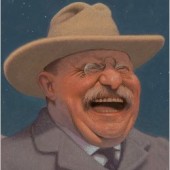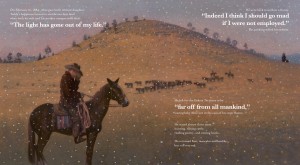2018 School Spending Survey Report
Teddy Roosevelt's 'Mighty Things' | An Interview with Doreen Rappaport
In her writing, Doreen Rappaport champions those who have wrestled with authority figures and great personal challenges—often risking their lives for a greater good. Her latest book examines the life of Teddy Roosevelt.
 In her writing, Doreen Rappaport champions those who have wrestled with authority figures and great personal challenges—often risking their lives for a greater good. Her book To Dare Mighty Things: The Life of Theodore Roosevelt, illustrated by C.F. Payne (Hyperion/Disney, December, 2013; Gr 2-5), joins her other standout picture-book biographies, including Martin's Big Words: the life of Dr. Martin Luther King, Jr., and others on Abraham Lincoln, Eleanor Roosevelt, and John F. Kennedy. As Rappaport remarked, "I only write about resistance, empowerment, and struggling to overcome obstacles." What drew you to Teddy Roosevelt as a subject? My husband collects everything to do with American presidential campaigns. He said, "Why haven't you written about Teddy Roosevelt? Kids will love him; he had asthma, hippopotamuses…." Roosevelt overcame so much; he was so resilient. He was incorruptible. He was a complex character and a very determined one. He's an extraordinary figure. We were struck by this quote, referring to his work as Civil Service Commissioner: "An office holder must do his duty for the whole people, not for any party or any faction." What would he say about politics today? Roosevelt would ask President Obama, "Why haven't you used the bully pulpit?" He would usurp power, which, of course, is not the best thing to do. If you look at the Panama Canal, from a political standpoint, [Roosevelt] was very impatient; he took the ball in his hands. As president he would have pushed senators to filibuster in his first year of office. I think he would have talked to the people. Teddy Roosevelt's causes were diverse, from nature conservancy to cleaning up political corruption. His interests were very diverse. Roosevelt wanted that canal through Panama because it would make it easier to ship goods. He wanted to change the meat factories. His will was made of steel. He was very well read. He was interested in everything. His curiosity was enormous.
In her writing, Doreen Rappaport champions those who have wrestled with authority figures and great personal challenges—often risking their lives for a greater good. Her book To Dare Mighty Things: The Life of Theodore Roosevelt, illustrated by C.F. Payne (Hyperion/Disney, December, 2013; Gr 2-5), joins her other standout picture-book biographies, including Martin's Big Words: the life of Dr. Martin Luther King, Jr., and others on Abraham Lincoln, Eleanor Roosevelt, and John F. Kennedy. As Rappaport remarked, "I only write about resistance, empowerment, and struggling to overcome obstacles." What drew you to Teddy Roosevelt as a subject? My husband collects everything to do with American presidential campaigns. He said, "Why haven't you written about Teddy Roosevelt? Kids will love him; he had asthma, hippopotamuses…." Roosevelt overcame so much; he was so resilient. He was incorruptible. He was a complex character and a very determined one. He's an extraordinary figure. We were struck by this quote, referring to his work as Civil Service Commissioner: "An office holder must do his duty for the whole people, not for any party or any faction." What would he say about politics today? Roosevelt would ask President Obama, "Why haven't you used the bully pulpit?" He would usurp power, which, of course, is not the best thing to do. If you look at the Panama Canal, from a political standpoint, [Roosevelt] was very impatient; he took the ball in his hands. As president he would have pushed senators to filibuster in his first year of office. I think he would have talked to the people. Teddy Roosevelt's causes were diverse, from nature conservancy to cleaning up political corruption. His interests were very diverse. Roosevelt wanted that canal through Panama because it would make it easier to ship goods. He wanted to change the meat factories. His will was made of steel. He was very well read. He was interested in everything. His curiosity was enormous. 
Interior spread illustration from 'To Dare Mighty Things' (Disney/Hyperion) copyright C.F. Payne
The spread, for "The light has gone out of my life," is so powerful. We see in C.F. Payne's painting that Roosevelt is heartbroken after his wife Alice's death, and that his only solace is in nature. Do you have any input on the illustrations for your books? The Dakota Territory was Roosevelt’s only solace. The artists I work with take the text and expand it on a level that's extraordinary. I’ve seen all the sketches for every book I’ve written except one. I do not get final approval of the artwork, and I never criticize the work. With Kadir Nelson illustrations for Abe's Honest Words (Hyperion/Disney, 2008) I saw the tiniest thumbnail sketches. Viewers see the little boy with the fishing rod and the big bushes. On the next page, they see the man with the lanky limbs and the big sky. Nelson added so much. Everyone loved Matt Tavares’s cover sketch for my book on JFK, Jack's Path of Courage (Hyperion/Disney, 2010), but I didn't think he'd caught the president’s vitality. The second sketch was much better; the third one caught Kennedy's cowlick, his huge smile, and Tavares put the sail behind him and the American flag. I said, “That's the cover.” Bryan Collier didn't do sketches for Martin's Big Words (Hyperion/Disney, 2007). I first saw the finished artwork; I love the image of the girl with the Afro against the American flag. Do you ever make changes to your text after you see the sketches? I often make changes to the text when I see the art. I was in Providence, RI, this week visiting schools. I showed the students a blow-up from Eleanor, Quiet No More (Hyperion/Disney, 2009) with FDR holding an umbrella, where the illustrator Gary Kelley had added a man rowing. Of course, FDR and Eleanor would have had a chaperone! Then I reordered my sentences to match the picture. We want the art to be visual poems. The way you handled the source of the American ship blown up in Cuba's harbor on February 15, 1898 was delicate. Teddy Roosevelt declared, "It was sunk by an act of dirty treachery by the Spaniards." You follow with, "It turned out he was wrong, but the U.S. declared war on Spain anyway." What sunk the ship is still debated, but you handled it well. I make decisions. Like with Martin Luther King. I state that he was shot, and he died. That was about death; people told me I handled King's death magnificently. This book is about American imperialism. It's about wanting colonies. The important thing was that Roosevelt was wrong [about the source of the Maine's explosion], but he also joined the war. You've done a number of picture-book biographies now. Have your other subjects called out to you? Each one calls out, but I have not been able to reduce any in the same way that I reduced Martin's Big Words. I wrote that book in three months. I went to the Schomburg Center in New York City. I read all the speeches, the interviews, the sermons. I had such a deep feeling. The experience was so immediate. But Martin Luther King, Jr. had one focus and Teddy Roosevelt had many. Eleanor Roosevelt was involved in many issues, as was JFK. When I started working with the editor Katherine Tegen, we looked at [old] biographies—people were making up quotes! That was the style in the 1950s! I think kids now are really blessed. They have writers like Joe Bruchac and Russell Freeman; I’m proud to be in the company of these authors. What have you learned about research over the years? Research is very creative. You have to be a detective and you have to use your imagination. If you hit a wall, you have to ask, where can I go? My tendency is to transform the material in some way that's appropriate to the material. My parents were in vaudeville; my mother was a singer. I found my own style. I'm really a children's book historian. Listen to Doreen Rappaport reveal the story behind To Dare Mighty Things, courtesy of TeachingBooks.net.
Listen to Doreen Rappaport reveal the story behind To Dare Mighty Things, courtesy of TeachingBooks.net. RELATED
RECOMMENDED
CAREERS
The job outlook in 2030: Librarians will be in demand
CAREERS
The job outlook in 2030: Librarians will be in demand
ALREADY A SUBSCRIBER? LOG IN
We are currently offering this content for free. Sign up now to activate your personal profile, where you can save articles for future viewing






Add Comment :-
Be the first reader to comment.
Comment Policy:
Comment should not be empty !!!